Sleeping Bag Tips.
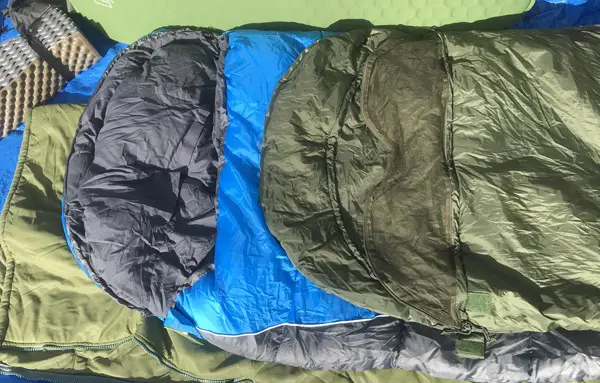
Getting the most out of your sleeping bag and taking care of it, can be easy with these simple ideas.
In this article we will cover some sleeping bag tips, like how to store a sleeping bag, how to stuff a sleeping bag and the best way to stay warm in a sleeping bag, etc.
1. How to store a sleeping bag.
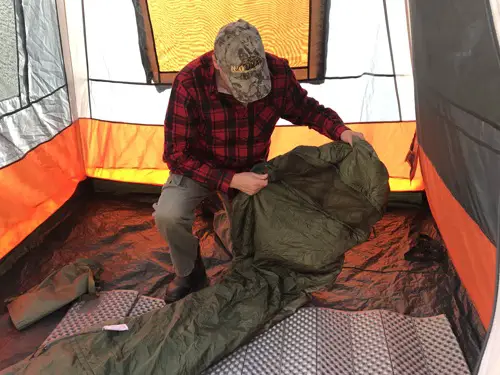
The compression straps on the sleeping bag cover, or a compression stuff sack are great for compacting the sleeping bag small. This is ideal for hiking, or packing the camping gear with limited space. However, for long term storage, the straps squash the loft, or filling material flat and it can lose some of its insulation properties.
So avoid leaving the compression straps tight on the bag all the time.
For long term storage, air the sleeping bag out first. When you put it back in the cover, undo the compression straps off and leave the drawstring lose, so the bag isn’t squashed.
Put the bag it in a dry place or cupboard, ensuring no heavy items are placed on it, or squashing it.
An even better idea for storing the sleeping bag long term is to put it in a breathable bag. Such as a big pillow case, mesh or cotton laundry bag which helps with the airflow.
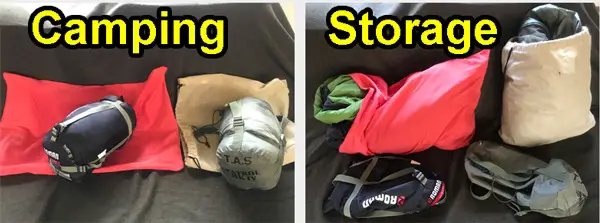
Make sure the bag is large enough not to compress the material. You can even buy sleeping bag storage bags, on Amazon or eBay.
You might even hang it down vertically in the wardrobe if you have room. Some bags have hanging straps on the foot box to help hang and air the sleeping bag out.
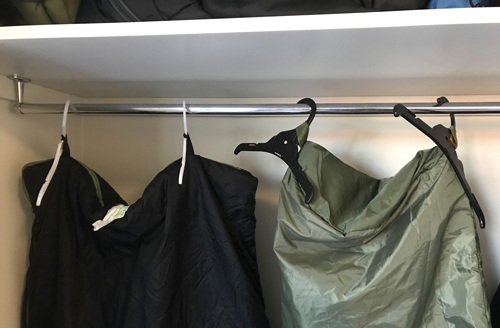
2. How to stuff a sleeping bag.
When you get a brand new sleeping bag, it will generally be rolled up in the cover. This is so it looks new and nicely packaged from the manufacturer. But for most sleeping bags, they are better packed away by stuffing the bag in the cover, rather than rolling it up.
Rolling the bag up captures a lot of air and makes it hard to fit it back in the undersized sleeping bag cover. (It reminds me of the tent bags, always too small to fit the tent back in. Don’t get me started on this subject.)
One easier way to pack the sleeping bag up is, to use the punch and rotate method. (I think I have made that term up, but it describes what action you do.)
1. Lay the sleeping bag out flat.
2. Hold the end, or foot box with one hand.
3. Smooth out the air pushing with the other hand.
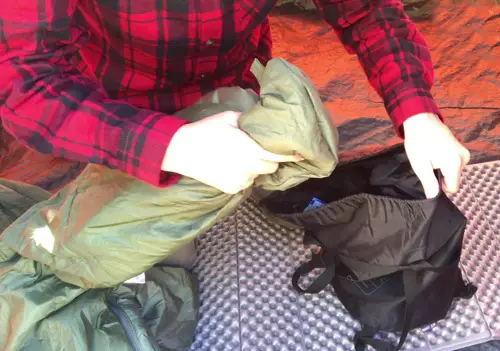
4. Hold the cover with one hand and start threading the sleeping bag end in.
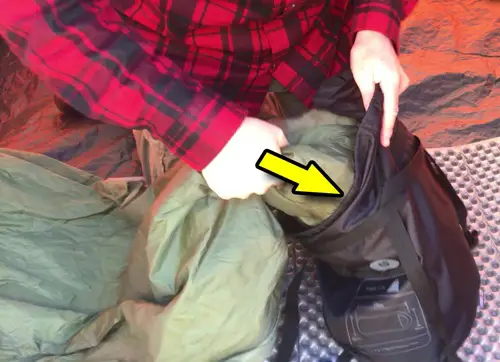
5. Grab the sleeping bag and punch it inside the cover.
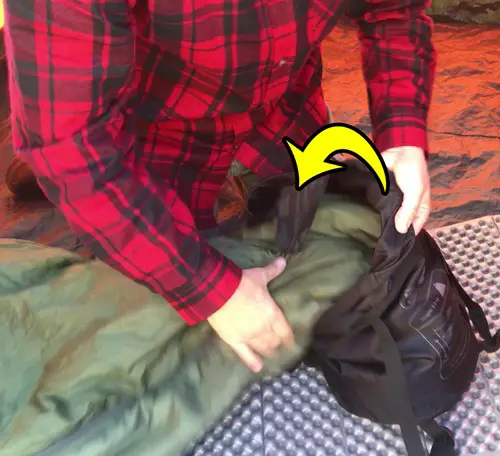
6. After you have punched the sleeping bag in the cover with one hand, rotate the cover around with the other hand. Punch the sleeping bag in and rotate the cover, repeat.
7. Punch and rotate, until the sleeping bag is all in the cover.
8. Close up the drawstring and / or cinch down the compression straps for traveling.
I normally tell my children when packing the sleeping bag up in its cover to, punch, punch rotate, punch, punch, rotate, etc.
(For military or tactical situations, stuffing the bag in, is a lot quicker than rolling up the sleeping bag.)
3. Sleeping bag care.
Sleeping bag care can be broken up into two areas. One is when you are in the field, such as camping, or hiking. The second is for preparing it for long term storage at home.
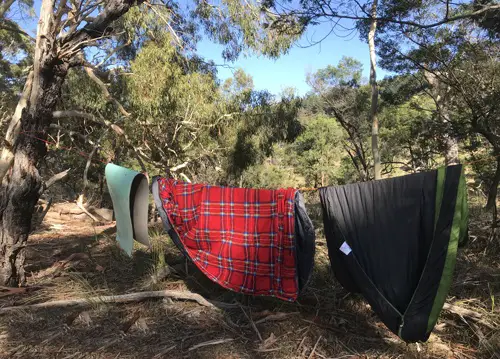
When camping, hang out the bedding frequently to air out. The tent and sleeping bag can get a lot of condensation, or might even get wet. In hot conditions the bag might get damp from sweat.
To dry the bag, unzip the bag and open it up, or turn it inside out, and hang it over a ridgeline. A bit of paracord strung between two trees is ideal. Check for insects before putting it away back in the tent or cover.
If the conditions are wet, you might be able to hang the bag vertically from the inside of the tent. Or use a tarp outside for covering it horizontally.
Preferably, do not hang the sleeping bag in direct sun in very hot places.
A dry bag is ideal for hiking, or long trips hunting and fishing in wet places. Ideally store the sleeping bag inside your back pack and in a dry bag as well.
If you don’t have room in your backpack and you have to hang the sleeping bag off your pack, unfortunately the sleeping bag underneath the back pack it is going to get dripped on. Having it high on top off the back pack, the bag will get wet as well, so a dry bag is a must for wet conditions.
A sleeping bag liner can also help keep the bag cleaner and is easier to wash the liner, rather than the sleeping bag.
If the sleeping bag does get dirty, check the manufactures washing instructions first before soaking it or cleaning it. We have talked about how to store a sleeping bag with breathable bags, etc., for long term storage. This is even more important if you do wash it, as it may not be totally dry.
4. Don’t unroll the sleeping bag too soon when camping.
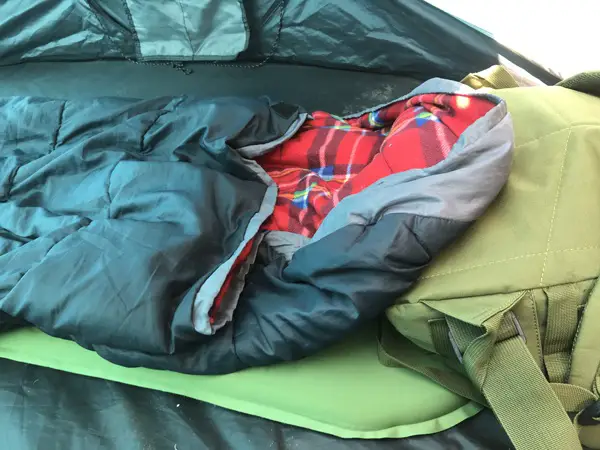
Don’t unroll your sleeping bag too early, as people getting in and out of the tent frequently can stand on the bedding and get it dirty. In muddy and wet conditions, keep the bag tidy and packed.
The same goes in camping places with lots of stinging creepy crawlies, like spiders, scorpions and centipedes, especially if camping under a tarp. So keep the sleeping bag in its cover, until it is time to get it out.
5. Shake out and fluff it out.
When you do unroll the sleeping bag, shake it out and fluff it up.
This allows the redistribution of materials and also the air to circulate and trap between the fibers or loft. If the insulation is compressed flat, the material or loft won’t trap air as efficiently.
6. Zipper cord.
If you haven’t got pull tabs on your sleeping bag zipper, attach some yellow or bright cordage loops or rings. (Paracord with a fisherman’s knot is ideal.) This makes the zipper easier to see, feel and grab when zipping up or unzipping the sleeping bag. Especially if you have thick gloves on.
You can also use glow in the dark, or reflective cordage that is easier to see at night time.
7. The best way to stay warm in a sleeping bag. More sleeping bag tips.
A good sleeping system is the best way to stay warm in a sleeping bag. Such as a combination of a sleeping mat, sleeping bag liner, pillow, etc. Appropriate thermal clothing and an extra blanket can help as well.
Here are some sleeping bag tips for getting extra warmth. All without upgrading to that expensive Arctic temperature, Mount Everest rated, sleep on the ice, built in smartphone sleeping bag that you need to mortgage the house to buy it, type of sleeping bag. (Well maybe it won’t be as warm as that, but these tips will help.)
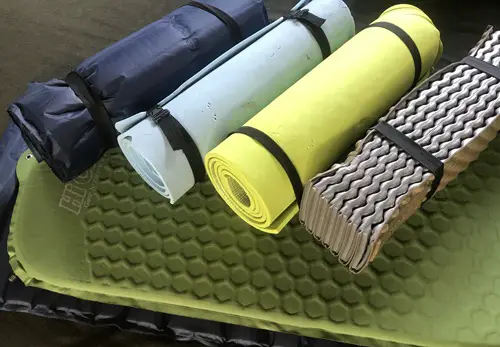
A sleeping pad or mat is crucial for getting off the cold ground. Even with a tent floor, tarp or ground sheet, it won’t insulate you from the ground. So a good sleeping mat will insulate the body from the ground, be warmer and more comfortable.
Covering up the extremities by wearing a beanie, gloves and fresh thick wool socks really helps keep the body warmer in a sleeping bag.
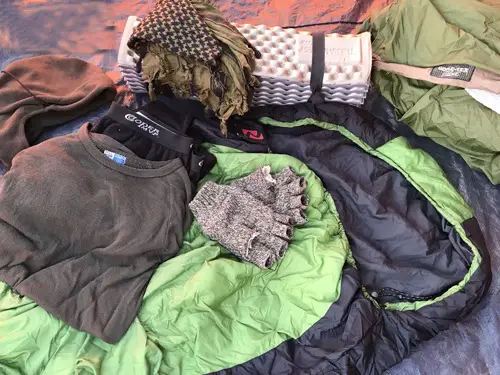
A thermal top and underwear is another way to stay warmer. It is also nice to change into fresh clean clothes for bed time.
Tighten up the drawstring around the hood and collar of the sleeping bag. This greatly helps reduce the heat escaping around the shoulders and head. A Shemagh around the shoulders also helps decrease the heat loss.
The stainless steel water bottle, filled with boiling water can some great extra warmth. Place the hot water bottle in a sock or article of clothing and place in the sleeping bag.
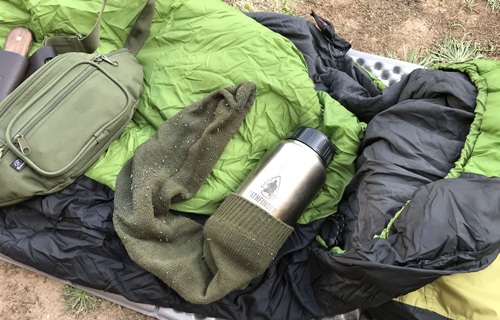
A sleeping bag liner such as a fleece material liner can increase the temperature of the bag. Rather than spend a lot of money for a new high end bag, a sleeping bag thermal liner might be worth looking into. A liner might also be made with cotton, silk or wool.
For hot nights the bag liner might just be used by itself, rather than in the sleeping bag.
The sleeping bag liner also helps increase the life of the sleeping bag as there is less wear internally. (Good for military personal on operations, who wear their boots inside the sleeping bag.)
Another tip is if you wake up to go to the toilet in the middle of the night, zip up your sleeping bag, or fold it over so all the heat isn’t lost out from the sleeping bag. (Instead of leaving the tent, a pee bottle might be used for cold areas.)
A bivy bag doesn’t have much insulation properties; however, it is another layer to trap air. Also for draughty tents or camping under tarps, the bivy bag is generally windproof and can stop a windy draft.
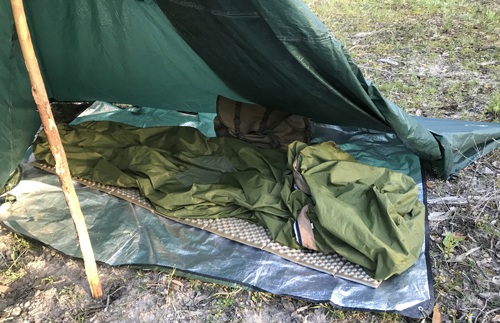
Another way to stay warm in a sleeping bag is to have your clothing close by you. If you do get cold in the night, you can put some layers of clothing on for extra warmth.
I sometimes put some of my clothes in the hood section of the sleeping bag. If I do wake up cold in the middle of the night, I know where to find the clothes and easily put them on. It also keeps your clothes warmer for the next morning to put on.
A fleece or wool blanket is another idea for extra warmth on top of the sleeping bag. While not ideal for the light weight hiker, the extra blanket for the car camper is an option in the tent or under the tarp.
Some of these above ideas are taken from my camping tips article.
Summary – Sleeping bag tips.
Whether you are camping, hiking, hunting or fishing in remote places, a proper sleep system and a few tips, can keep you a lot warmer in your sleeping bag at night.
By caring for your sleeping bag with some of these ideas, it will last for years and years and perform better. I hope you enjoyed these sleeping bag tips.
